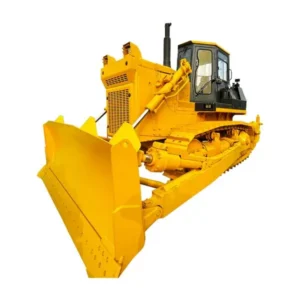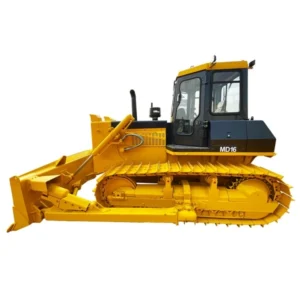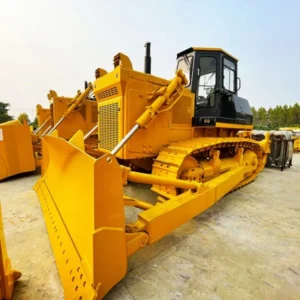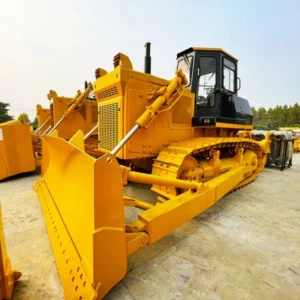Welcome to My Blog!
Before we dive into the content, I’d love for you to join me on my social media platforms where I share more insights, engage with the community, and post updates. Here’s how you can connect with me:
Facebook:https://www.facebook.com/profile.php?id=100066759548969
Now, let’s get started on our journey together. I hope you find the content here insightful, engaging, and valuable.
معرفی
Selecting the right construction bulldozer for your site is crucial to ensuring the efficiency, safety, and success of your project. With the wide variety of bulldozers available on the market, each designed for specific tasks and terrains, making an informed choice can be challenging. This guide will walk you through the key factors to consider when choosing the best construction bulldozer for your site, helping you match the right machine to your specific needs.
Understanding the Role of a Construction Bulldozer

Before diving into the selection process, it’s important to understand the fundamental role of a construction bulldozer on a job site. Bulldozers are powerful, heavy-duty machines designed to move large amounts of earth, debris, and other materials. They are commonly used for:
- Site preparation: Clearing land, removing trees, and grading surfaces.
- Road construction: Creating level ground for roads and highways.
- Demolition: Breaking down structures and pushing debris.
- Mining and quarrying: Extracting materials and clearing overburden.
- محوطه سازی: Shaping terrain and creating slopes.
Each of these tasks requires a bulldozer with specific features and capabilities, making it essential to choose a machine that aligns with your project’s demands.
Key Factors to Consider When Choosing a Construction Bulldozer
When selecting a construction bulldozer, several factors come into play. These factors will help you determine the type and size of bulldozer that will be most effective for your project.
Project Requirements and Scope
Understanding the specific needs of your project is the first step in choosing the right bulldozer. Consider the following:
- Size of the site: Larger sites may require bigger bulldozers with more power, while smaller sites might be better suited for compact models.
- Type of terrain: Bulldozers designed for rugged, uneven terrain may differ from those used on flat or soft ground.
- Material to be moved: The weight and type of material (e.g., soil, rock, debris) will influence the bulldozer’s blade size, power, and traction requirements.
- Duration of the project: Long-term projects may benefit from durable, high-performance bulldozers, while short-term projects might prioritize cost-effectiveness.
Bulldozer Size and Power
Bulldozers come in various sizes, from small and compact models to large, heavy-duty machines. The size of the bulldozer you need will depend on:
- Horsepower (HP): Higher horsepower bulldozers are suitable for tougher tasks, such as moving heavy materials or working on steep slopes.
- Weight: Heavier bulldozers provide better stability and traction, especially on rough terrain.
- Blade size and type: Larger blades can move more material in a single pass but may require more power and space to operate effectively.
Blade Type and Configuration
The blade is the most critical part of a bulldozer, and its type and configuration will determine the machine’s functionality. Common blade types include:
- Straight Blade (S-Blade): Ideal for fine grading and leveling.
- Universal Blade (U-Blade): Designed for pushing large quantities of material.
- Semi-U Blade: A combination of S-Blade and U-Blade, offering versatility for both grading and material movement.
- Angle Blade: Allows the blade to be angled for side casting material.
- Power-Angle-Tilt Blade (PAT Blade): Provides maximum flexibility with angle, tilt, and rotation adjustments.
Undercarriage Type
The undercarriage of a bulldozer plays a vital role in its ability to traverse different terrains. The main types of undercarriages include:
- Standard (Rigid) Undercarriage: Suitable for general construction tasks on stable ground.
- Low Ground Pressure (LGP) Undercarriage: Designed for soft or marshy terrain, distributing the machine’s weight to prevent sinking.
- High-Track Undercarriage: Offers better traction and reduced wear on rough or uneven terrain.
Operator Comfort and Controls
Modern bulldozers are equipped with various features to enhance operator comfort and ease of use, which can impact productivity. Consider the following:
- Cab design: Look for a cab with good visibility, ergonomic seating, and climate control.
- Control systems: Advanced control systems, including joystick and automated controls, can simplify operation and reduce operator fatigue.
- Safety features: Ensure the bulldozer is equipped with essential safety features, such as rollover protection structures (ROPS) and seatbelts.
Maintenance and Support
Regular maintenance is crucial to keeping a bulldozer in optimal condition. When choosing a bulldozer, consider:
- Ease of maintenance: Machines with easily accessible components will reduce downtime and maintenance costs.
- Availability of parts: Ensure that replacement parts are readily available and affordable.
- Dealer support: Choose a manufacturer or dealer with a strong support network for service and repairs.
Table: Comparison Between Construction Bulldozers and Excavators
| Feature | Construction Bulldozers | کاوشگران |
|---|---|---|
| Primary Function | Pushing, grading, and leveling materials | Digging, trenching, and lifting materials |
| Common Attachments | Blades (Straight, U-Blade, Angle, PAT Blade) | Buckets, hammers, grapples, augers |
| قابلیت مانور | Typically less maneuverable, better for open spaces | Highly maneuverable, ideal for confined spaces |
| Terrain Handling | Excellent on flat, open terrain; can struggle in tight or rocky areas | Versatile across various terrains, including rough and uneven surfaces |
| Operation Complexity | Generally simpler to operate with fewer controls | More complex to operate, with multiple functions and attachments |
| تطبیق پذیری | Primarily used for earthmoving, not as versatile in other tasks | Extremely versatile, can be used for multiple tasks with various attachments |
| Speed | Slower, designed for pushing materials over short distances | Faster, can move quickly between tasks |
| Size and Power | Typically larger and more powerful, designed for heavy-duty tasks | Available in various sizes, from mini to large excavators |
| Project Types | Ideal for site preparation, road construction, and demolition | Suitable for digging foundations, trenching, and material handling |
| هزینه | Generally lower cost compared to excavators of similar capacity | Typically higher cost due to versatility and advanced technology |
Matching the Bulldozer to Your Specific Site Needs

Every construction site has unique requirements, and selecting the right bulldozer involves more than just comparing specs. Here are some tips on how to align your choice with the specific needs of your site:
Assessing Site Conditions:
- Terrain: Evaluate the terrain’s condition, including slope, soil type, and stability, to determine the necessary traction and stability features.
- Space Constraints: If working in confined spaces, consider a smaller, more maneuverable bulldozer with a PAT Blade for versatility.
Evaluating Material Types:
- Soft Materials: For loose or soft materials like sand or soil, a bulldozer with an LGP undercarriage and a large blade will be more efficient.
- Hard Materials: For harder materials such as rocks or compacted soil, a bulldozer with higher horsepower and a strong, durable blade is necessary.
Considering Project Phases:
- Initial Site Preparation: For clearing and leveling, a bulldozer with a universal or angle blade will be most effective.
- Detailed Grading: For finer grading tasks, a PAT Blade on a smaller bulldozer can provide precision and control.
Budgeting for Your Bulldozer:
- New vs. Used: Consider whether a new or used bulldozer fits your budget. New bulldozers offer the latest features and reliability, while used models can be more cost-effective if well-maintained.
- Operational Costs: Factor in fuel efficiency, maintenance, and operator costs when budgeting for your bulldozer.
نتیجه
Choosing the best construction bulldozer for your site is a decision that requires careful consideration of various factors, including the project’s scope, terrain, and specific tasks. By understanding the different types of bulldozers, their features, and how they align with your project needs, you can make an informed choice that enhances productivity and ensures the success of your construction project. Whether you’re preparing a site, building a road, or landscaping, the right bulldozer will be an invaluable asset on your job site.
سوالات متداول
What is the most important factor to consider when choosing a construction bulldozer?
- The most important factor is aligning the bulldozer’s capabilities with the specific needs of your project, including the type of terrain, materials, and tasks.
How do I determine the right blade type for my bulldozer?
- Choose a blade type based on the primary tasks: a straight blade for fine grading, a universal blade for moving large amounts of material, and a PAT Blade for versatility.
Is a high-horsepower bulldozer always better?
- Not necessarily. While higher horsepower is beneficial for heavy-duty tasks, smaller projects may require a more maneuverable, lower-horsepower bulldozer.
Can a construction bulldozer be used for landscaping?
- Yes, bulldozers are commonly used in landscaping for tasks such as grading, creating slopes, and clearing land.
What are the benefits of a Low Ground Pressure (LGP) undercarriage?
- An LGP undercarriage distributes the machine’s weight over a larger area, reducing the risk of sinking and making it ideal for soft or marshy terrain.
How do I ensure my bulldozer is safe to operate?
- Ensure the bulldozer has essential safety features like ROPS, keep it well-maintained, and provide proper training for operators.
Should I buy or rent a construction bulldozer?
- The decision depends on the project’s duration and frequency. Renting is cost-effective for short-term projects, while buying is better for long-term use.
How does terrain type affect bulldozer selection?
- Rough, uneven terrain requires a bulldozer with high traction and stability features, while flat terrain may allow for a simpler, lighter machine.
What are the latest technological advancements in construction bulldozers?
- Modern bulldozers feature GPS systems, automated controls, and enhanced fuel efficiency, improving precision and reducing operational costs.
How often should a construction bulldozer be maintained?
- Regular maintenance should be performed according to the manufacturer’s schedule, typically every 250-500 hours of operation, depending on usage and conditions.








-150x150.webp)
